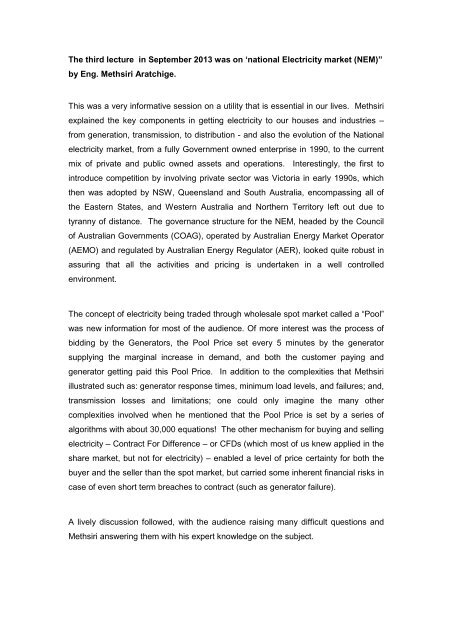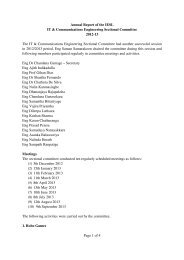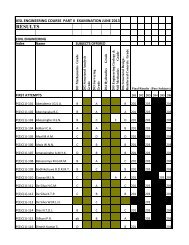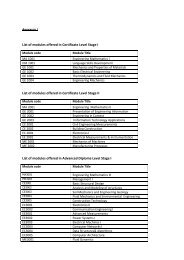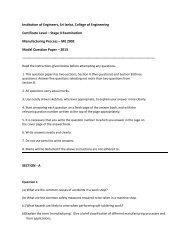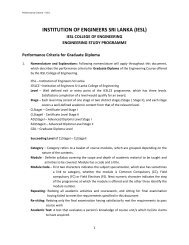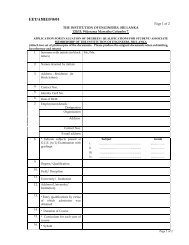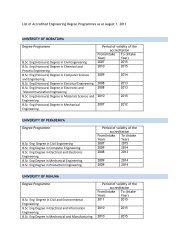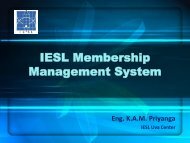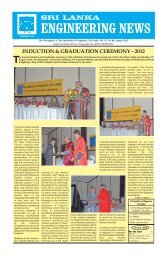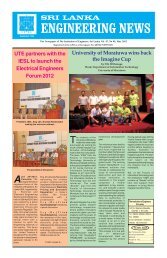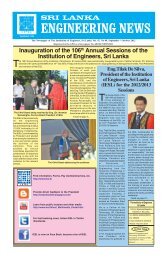1 Annual Report - The Institution of Engineers Sri Lanka
1 Annual Report - The Institution of Engineers Sri Lanka
1 Annual Report - The Institution of Engineers Sri Lanka
- No tags were found...
Create successful ePaper yourself
Turn your PDF publications into a flip-book with our unique Google optimized e-Paper software.
<strong>The</strong> third lecture in September 2013 was on ‘national Electricity market (NEM)”by Eng. Methsiri Aratchige.This was a very informative session on a utility that is essential in our lives. Methsiriexplained the key components in getting electricity to our houses and industries –from generation, transmission, to distribution - and also the evolution <strong>of</strong> the Nationalelectricity market, from a fully Government owned enterprise in 1990, to the currentmix <strong>of</strong> private and public owned assets and operations. Interestingly, the first tointroduce competition by involving private sector was Victoria in early 1990s, whichthen was adopted by NSW, Queensland and South Australia, encompassing all <strong>of</strong>the Eastern States, and Western Australia and Northern Territory left out due totyranny <strong>of</strong> distance. <strong>The</strong> governance structure for the NEM, headed by the Council<strong>of</strong> Australian Governments (COAG), operated by Australian Energy Market Operator(AEMO) and regulated by Australian Energy Regulator (AER), looked quite robust inassuring that all the activities and pricing is undertaken in a well controlledenvironment.<strong>The</strong> concept <strong>of</strong> electricity being traded through wholesale spot market called a “Pool”was new information for most <strong>of</strong> the audience. Of more interest was the process <strong>of</strong>bidding by the Generators, the Pool Price set every 5 minutes by the generatorsupplying the marginal increase in demand, and both the customer paying andgenerator getting paid this Pool Price. In addition to the complexities that Methsiriillustrated such as: generator response times, minimum load levels, and failures; and,transmission losses and limitations; one could only imagine the many othercomplexities involved when he mentioned that the Pool Price is set by a series <strong>of</strong>algorithms with about 30,000 equations! <strong>The</strong> other mechanism for buying and sellingelectricity – Contract For Difference – or CFDs (which most <strong>of</strong> us knew applied in theshare market, but not for electricity) – enabled a level <strong>of</strong> price certainty for both thebuyer and the seller than the spot market, but carried some inherent financial risks incase <strong>of</strong> even short term breaches to contract (such as generator failure).A lively discussion followed, with the audience raising many difficult questions andMethsiri answering them with his expert knowledge on the subject.


